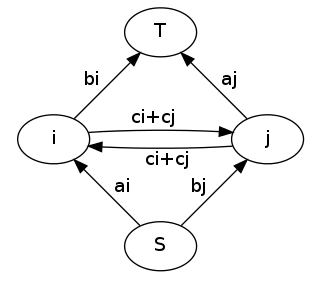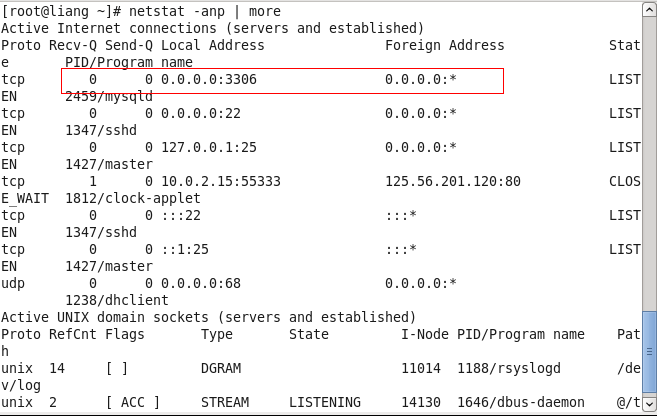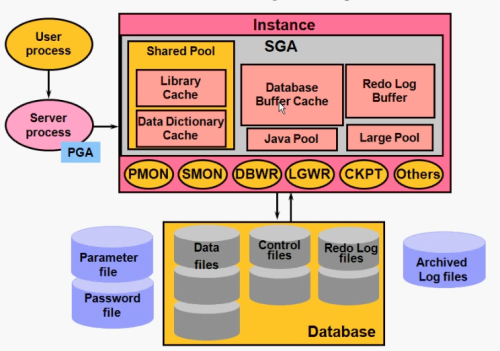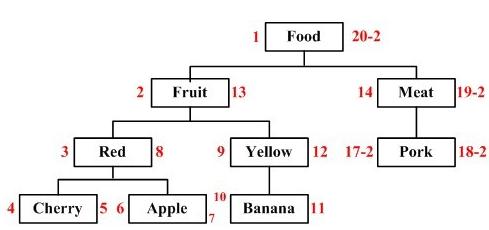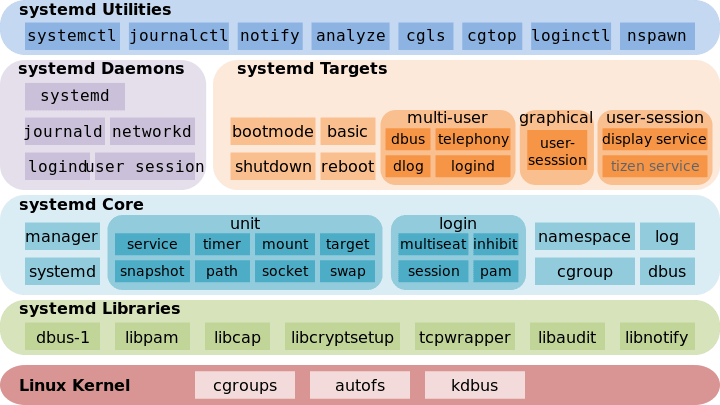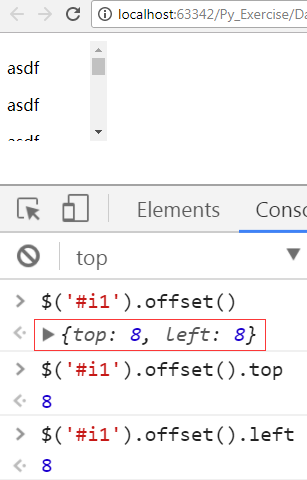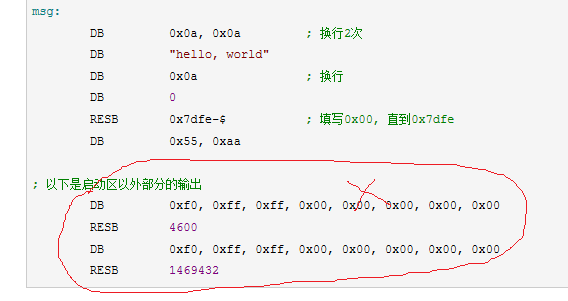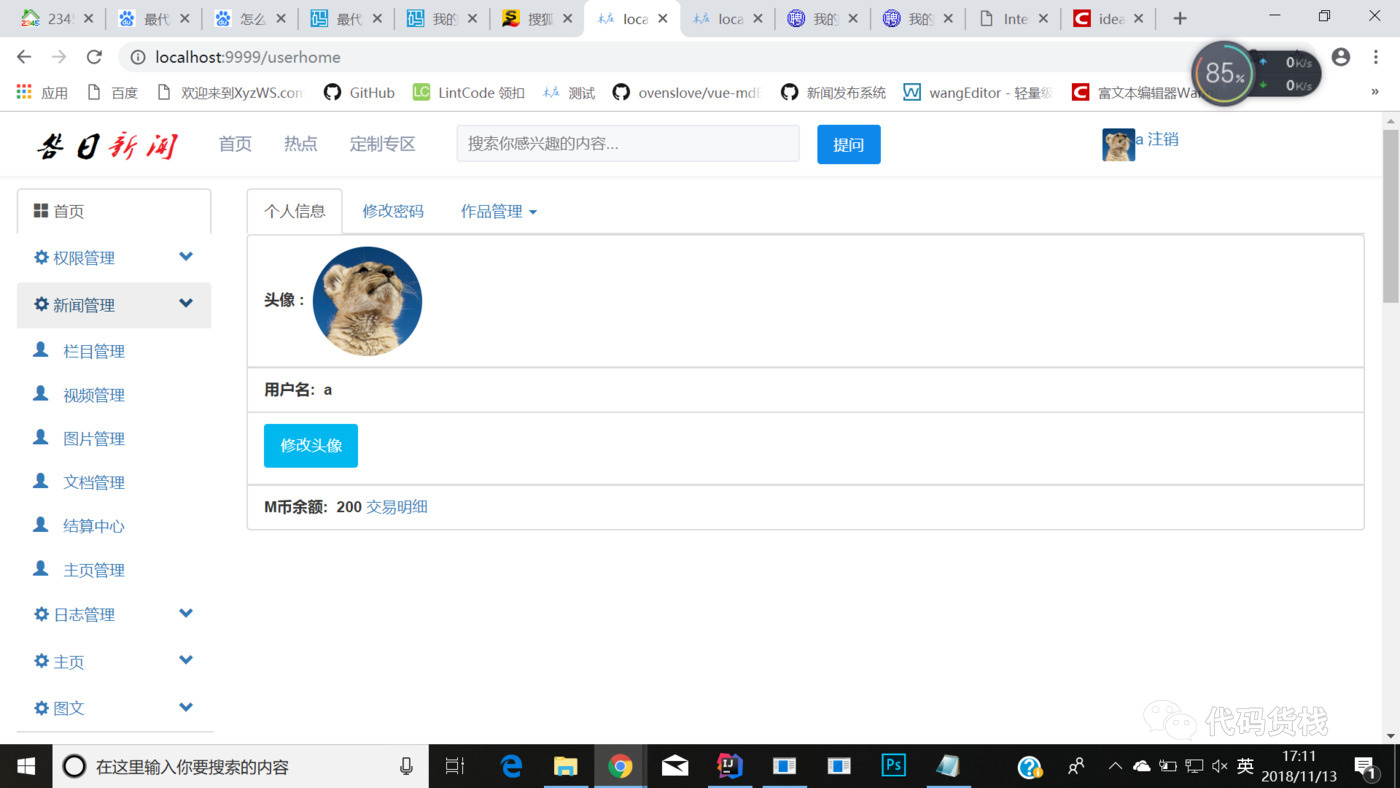1,前言
本文期望描述如何使用Shiro构建基本的安全登录和权限验证。本文实战场景有如下特殊需求:1,在集群和分布式环境实现session共享;2,前端只使用HTML/CSS/JS。因此无法直接使用Shiro提供的SessionManager,以及Shiro针对web应用提供的Filter拦截方式。当然,除非是一定要通过共享缓存的方式共享session,否则还是使用Shiro默认的session管理,毕竟增加独立缓存就意味着维护成本的提高和可用性的下降。
2, Shiro架构
首先一睹官方给出的Shiro架构图,如图1所示。刨除最右侧的加密工具类,主要围绕SercurityManager来阐述。SercurityManager是Shiro安全框架里的顶层安全管理中心,所有安全控制相关逻辑都是在SercurityManager里面通过delegate的方式,调用到真正的动作执行者。从图1可以清楚看到主要管理的组件:authentication管理,authorization管理,session管理,session缓存管理,cache管理,realms管理。(本文不想重复已有的文字,想要更好的了解Shiro,详见官方推荐的Shiro full intro: https://www.infoq.com/articles/apache-shiro)
1)Shiro提供的CacheManager比较单薄,提供实现是MemoryConstrainedCacheManager,主要是依赖SoftHashMap来做基于内存条件的缓存,也即是当内存吃紧,没有新的内存空间来存放new出来的对象时,会去释放SoftHashMap中存放的对象,在本文中的应用场景是面向集群和分布式应用环境,使用了Redi缓存登录用户的相关信息,所以需要自定义cache处理。
2)Shiro对于session的缓存管理,定义了SessionDAO抽象,并提供了两个存放于本地JVM内存的EnterpriseCacheSessionDAO和MemorySessionDAO,两者主要区别是EnterpriseCacheSessionDAO的session存放在SoftHashMap中,原则上可以自己实现SessionDAO 接口,实际存储使用Redis来做到完整的session共享,但是缺陷是:a,不安全,因为把所有数据都共享出去了;b,当每次需要获取session数据时,都需要通过网络来把整个session反序列化回来,而考虑很多情况下,只是间断的需要几个key的数据,这样在session数据量大一些的时候,就会产生大量消耗。因此在共享session时,不去替换默认SessionDao的实现,而是通过@overwrite AbstractNativeSessionManager getter/setter attribute方法,实现有选择的共享session的基本初始化和指定attribute key的数据。
3)Shiro的authentication和authorization过程主要是依据用户定义的 AuthorizingRealm中提供的AuthenticationInfo和AuthorizationInfo。特别地,authentication 还提供类似验证链的authentication策略,允许用户提供多个Realm。第3部分会具体的示例Shiro集成Spring的使用范例,并详细解释AuthorizingRealm 。

图 1 Shiro官方架构图
3, Shiro使用范例
官方提供了集成Spring Web应用的使用例子,但是就如前文提到的,这里前端只能使用JS的Http和后端通信,因此无法直接使用ShiroFilterFactoryBean来做Request的Filter。本文鉴于简单和初期的原则,可以选择定义一个RequestInterceptor类继承HandlerInterceptorAdapter并overwrite preHandle 方法。Interceptor的applicationContext和源码定义如下:
applicationContext.xml
1 <mvc:interceptors> 2 <mvc:interceptor> 3 <mvc:mapping path="/**"/> 4 <!--拦截的url --> 5 <mvc:mapping path="/admin/**"/> 6 <!-- 不拦截的url start --> 7 <mvc:exclude-mapping path="/admin/login"/> 8 <mvc:exclude-mapping path="/admin/code"/> 9 <mvc:exclude-mapping path="/admin/logout"/> 10 <mvc:exclude-mapping path="/admin/msgErrorInfo"/> 11 <!--不拦截的url end --> 12 <bean class="authorizing.RequestInterceptor"> 13 <property name="unauthenticatedUrl" value="/admin/msgErrorInfo" /> 14 </bean> 15 </mvc:interceptor> 16 </mvc:interceptors>
RequestInterceptor.java
1 public class RequestInterceptor extends HandlerInterceptorAdapter { 2 3 private String unauthenticatedUrl; 4 5 public boolean preHandle(HttpServletRequest request, HttpServletResponse response, 6 Object handler) throws Exception { 7 if(PermissionUtils.isLogin(request)){ 8 return true; 9 } 10 //token已失效,返回提示信息 11 request.getRequestDispatcher(unauthenticatedUrl).forward(request, response); 12 return false; 13 } 14 15 public void setUnauthenticatedUrl(String unauthenticatedUrl) { 16 this.unauthenticatedUrl = unauthenticatedUrl; 17 } 18 }
RequestInterceptor.java定义非常简单,主要是在preHandler方法中验证了一下请求是否是登录用户发出的,否则响应给前端一个重定向。然后看一下PermissionUtils.isLogin(request)是怎样做登录验证的。
PermissionUtils.java
1 public class PermissionUtils { 2 private static ThreadLocal<String> sessionToken = new ThreadLocal<String>(); 3 4 public static boolean isLogin(HttpServletRequest request){ 5 String token = sessionToken(request); 6 if(StringUtils.isEmpty(token)) 7 return false; 8 /** 9 * 使用token检查是否存在登录session 10 */ 11 //Session session = SecurityUtils.getSecurityManager().getSession(new WebSessionKey(token, request, response)); 12 Session session = SecurityUtils.getSecurityManager().getSession(new DefaultSessionKey(token)); 13 if(session != null){ 14 session.touch(); 15 sessionToken.set(token); 16 return true; 17 } 18 return false; 19 } 20 21 private static String sessionToken(HttpServletRequest request){ 22 return request.getHeader("token"); 23 } 24 }
从PermissionUtils.java可以判断,保存前后端session的方式是通过token的形式。也即是每次request中的header部分都携带了登录成功后获取的token,以token为标识获取登录用户的session。特别地,对于Shiro而言,session并非特定于Web应用,Shiro有自己的session定义,可以独立于应用环境而存在。因此为了追求简单(既已弃用了Shiro针对web.xml应用提供的Filter),直接使用Shiro创建的默认session(实际是SimpleSession)。此外,需要说明的一个细节是通过Shiro的SecurityManager 返回的session实际都是一个代理(DelegatingSession的实例)。因此,通过 SecurityManager获取的session,然后对session执行的动作实际都是通过 SecurityManager的SessionManager来完成的(因为共享session,每一次session的touch动作都应该反映到共享session中,后文,可以看到overwrite SessionManager#touch(SessionKey key)和start session)。Shiro提供的默认SessionManager都继承了AbstractValidatingSessionManager$sessionValidationSchedulerEnabled属性,该属性控制了是否执行一个后台守护线程(Thread#setDaemon(true))在给定的一个固定时间间隔(默认1个小时)内周期性的检查session是否过期,并且在每一次获取到session之后都会去检查session是否过期(对于共享session的集群,共享缓存基本都已具备超时管理功能,所以可以重新实现后文提到的 AbstractNativeSessionManager#getSession(SessionKey))。PermissionUtils.java中定义了一个ThreadLocal类型的sessionToken变量,该变量是用于暂存当前request authentication成功之后的session标识,避免每次获取token都要从request中拿(后文中使用到的每一个url的authorization都需要首先执行一次checkPermission方法,通过token来验证是否有访问权限)。
接下来描述Authentication和Authorization,具体地说明如何基于Shiro实现login和check permission。下面先给出applicationContext配置。
applicationContext.xml
<bean id="securityManager" class="org.apache.shiro.mgt.DefaultSecurityManager"><property name="realm" ref="authorizingRealm" /><property name="sessionManager"><bean class="service.authorizing.shiro.RedisSessionManager" ><property name="globalSessionTimeout" value="${session.timeout}" /></bean></property> </bean> <bean id="realmCache" class="service.authorizing.shiro.cache.RedisShiroCache" /> <bean id="authorizingRealm" class="service.authorizing.shiro.DefaultAuthorizingRealm"><property name="authorizationCachingEnabled" value="true"/><property name="authorizationCache" ref="realmCache" /> </bean> <bean id="lifecycleBeanPostProcessor" class="org.apache.shiro.spring.LifecycleBeanPostProcessor"/><bean class="org.springframework.beans.factory.config.MethodInvokingFactoryBean"><property name="staticMethod" value="org.apache.shiro.SecurityUtils.setSecurityManager"/><property name="arguments" ref="securityManager"/> </bean>
applicationContext.xml中配置的DefaultSecurityManager,RedisSessionManager,DefaultAuthorizingRealm和RedisShiroCache,分别代表Shiro的默认SecurityManager,自定义基于Redis的session manager,继承自Shiro的AuthorizingRealm的默认实现,以及自定义基于Redis的用户权限相关的Cache<Object, AuthorizationInfo>实现。注意到,本文的应用场景虽然是web.xml应用,但是并没有使用Shiro提供的 DefaultWebSecurityManager和DefaultWebSessionManager这两个针对web应用的拓展。使用针对web应用的拓展实现自然也没问题,但是个人认为对于纯粹的前后端分离权限认证的应用场景中,前端和后端应当是完全独立的,它们之间唯一的耦合是通过Http request交互的token。因此就目前简单和初期的原则,不需要DefaultWebSecurityManager和DefaultWebSessionManager。
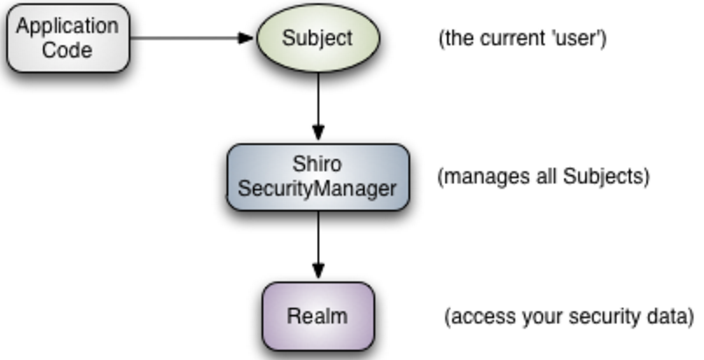
图2 Shiro组件交互过程
在讲解程序具体怎样执行login和check permission之前,先看图2所示的Shiro各组件的交互过程,可以看到Real是安全验证的依据。所以有必要先理解Shiro提供的abstract类AuthorizingRealm,该类定义了两个抽象方法doGetAuthorizationInfo和doGetAuthenticationInfo,分别用于check permission和login验证。具体如下DefaultAuthorizingRealm.java的定义:
DefaultAuthorizingRealm.java
1 public class DefaultAuthorizingRealm extends AuthorizingRealm { 2 3 @Autowired 4 private AuthorizingService authorizingService; 5 6 /** 7 * 获取登录用户角色和功能权限信息, 8 * 使用{@link org.apache.shiro.cache.CacheManager}和{@link org.apache.shiro.cache.Cache}获取数据. 9 * @param principals 登录用户ID 10 * @return 11 */ 12 protected AuthorizationInfo doGetAuthorizationInfo(PrincipalCollection principals) { 13 Object username =principals.getPrimaryPrincipal(); 14 Cache<Object, AuthorizationInfo> infoCache = getAuthorizationCache(); 15 AuthorizationInfo info = infoCache.get(username); 16 return info; 17 } 18 19 /** 20 * 根据登录用户token,获取用户信息。 21 * 对于session timeout时间较短的场景可以考虑使用AuthenticationCache 22 * 若验证失败,会抛出异常 {@link AuthenticationException} 23 * @param token 24 * @return 25 * @throws AuthenticationException 26 */ 27 protected AuthenticationInfo doGetAuthenticationInfo(AuthenticationToken token) throws AuthenticationException { 28 Object username = token.getPrincipal(); 29 //对于session timeout时间较短的场景,可缓存用户authentication信息 30 //Cache<Object, AuthenticationInfo> infoCache = getAuthenticationCache(); 31 //return infoCache.get(username); 32 return authorizingService.authentication(username); 33 } 34 }
DefaultAuthorizingRealm.java的实现,可以看到用户只需要通过 doGetAuthorizationInfo和doGetAuthenticationInfo两个方法给Shiro的SecurityManager提供Authorization和Authentication信息,SecurityManager就会在执行check permission和login操作时自动调用这两个函数来验证操作。下面我们再看执行login和check permission操作时具体做了什么。
- Authentication
下面在LoginController.java定义了login请求操作。
LoginController.java
1 @Controller 2 @RequestMapping("/admin") 3 public class LoginController { 4 Logger logger = LoggerFactory.getLogger(LoginController.class); 5 6 @Autowired 7 private AuthorizingService authorizingService; 8 9 @RequestMapping("/login") 10 @ResponseBody 11 public LoginToken login(User user, HttpServletRequest request){ 12 Subject subject = new Subject.Builder().buildSubject(); 13 UsernamePasswordToken token = new UsernamePasswordToken(userName, UtilTool.md5Tool(password)); 14 token.setRememberMe(true); 15 LoginToken loginToken = new LoginToken(); 16 try{ 17 subject.login(token); 18 Session session = subject.getSession(); 19 user.setToken((String) session.getId()); 20 loginToken.setResultCode(WebConstants.RESULT_SUCCESS_CODE); 21 } catch (AuthenticationException e) { 22 loginToken.setResultCode(WebConstants.RESULT_FAIL_CODE); 23 loginToken.setMessage("用户名或密码错误!"); 24 } 25 return loginToken; 26 } 27 }
上述login代码只做了非常简单用户名和密码的验证示例。可以看出login如果没有抛出AuthenticationExeception,则说明登录成功。
- Authorization
访问权限控制需要在所有的访问controller的函数中配置,因此使用工具类最合适(在工具类的基础上做成spring annotation也可以很方便),既是PermissionUtils.java。
PermissionUtils.java
1 private static AuthorizingService authorizingService; 2 3 private static ThreadLocal<String> sessionToken = new ThreadLocal<String>(); 4 5 /** 6 * 7 * @param url eg: /admin/review 8 * @param argv eg: WAIT_BIZ_MANAGER 9 */ 10 public static void checkPermission(String url, @Nullable String argv){ 11 Subject subject = getSubject(); 12 String permissionCode = authorizingService.uriMappingCode(url, argv); 13 if(StringUtils.isEmpty(permissionCode)) 14 throw new IllegalArgumentException("不明操作"); 15 subject.checkPermission(permissionCode); 16 } 17 18 public static Subject getSubject(){ 19 String token = sessionToken.get(); 20 if(StringUtils.isEmpty(token)) 21 throw new AuthenticationException("未经认证"); 22 return new Subject.Builder() 23 .sessionId(sessionToken.get()) 24 .buildSubject(); 25 } 26 27 public static void setAuthorizingService(AuthorizingService authorizingService) { 28 PermissionUtils.authorizingService = authorizingService; 29 }
从上述代码来看,每一个request的checkPermission操作,都需要依赖前文RequestInterceptor.java中提到的,从request中获取的token,并依赖该token找到缓存的session 。在权限控制的设计时,不同的业务场景可能需要不同粒度的权限控制,在这里做到了request参数级别的权限控制(在workflow应用中,一个流程涉及多个角色的参与,但很可能只抽象一个接口,如下文的/review操作)。在实现的时,灵活的方式是可以维护一张uri和permission_code之间的关系表(简单可以propertites文件)。对于前端用户而言,为了提升用户体验,拥有不同权限的用户得到的界面会有相应的隐藏和显示,因此会给前端的登录用户提供一张可访问权限表。在这里一个细节的设计,个人觉得有意义的是,在返回给前端的权限表的Key值不应当是permission_code,而是uri。因为permission_code对于前端而言毫无意义,而uri正是前后端沟通的桥梁。因此,check Permission操作可以如下:
ReviewApiController.java
1 @RestController 2 @RequestMapping(value = "/review") 3 public class ReviewApiController { 4 5 @Autowired 6 private ReviewService reviewService; 7 8 @ResponseBody 9 @RequestMapping(value = "/review", method = POST) 10 public WebResult review(@RequestBody NewReviewVo reviewVo){ 11 //检查访问权限 12 PermissionUtils.checkPermission("/review/review", reviewVo.getFeatureCode()); 13 WebResult result = WebResult.successResult(); 14 try { 15 Review review = ReviewAssembler.voToReview(reviewVo); 16 reviewService.review(review); 17 }catch (Exception e){ 18 result = WebResult.failureResult(e.getMessage()); 19 } 20 return result; 21 } 22 }
- SessionManager
由于要实现有选择的共享session数据,因此session管理成了最棘手的问题,因为你不是粗暴地将整个session序列化到缓存并仍以local session的方式管理,其间需要额外得小心处理共享的session数据和本地的session数据。下面给出RedisSessionManager.java的实现:
RedisSessionManager.java


1 /** 2 * 根据 attributeKey,有选择的缓存session信息; 3 * 设置 {@parm enabledSharedSessionData}来有选择的启用共享session功能。 4 */ 5 public class RedisSessionManager extends DefaultSessionManager { 6 7 private static Logger logger = LoggerFactory.getLogger(RedisSessionManager.class); 8 9 private boolean enabledSharedSessionData; 10 11 private Set<String> sharedSessionDataKeys; 12 13 public RedisSessionManager() { 14 enabledSharedSessionData = true; 15 sharedSessionDataKeys = new HashSet<String>(); 16 } 17 18 @Override 19 public Collection<Object> getAttributeKeys(SessionKey key) { 20 21 Collection<Object> keys = super.getAttributeKeys(key); 22 if(enabledSharedSessionData) { 23 /** 24 * 从redis获取 {@param key} 对应session的所有attribute key 25 */ 26 Set sharedKeys = RedisClient.extractAttributeKey((String) key.getSessionId()); 27 keys.addAll(sharedKeys); 28 } 29 return keys; 30 } 31 32 @Override 33 public Object getAttribute(SessionKey sessionKey, Object attributeKey) 34 throws InvalidSessionException { 35 if(checkSharedStrategy(attributeKey)){ 36 Object object = RedisClient.getValue((String) attributeKey, (String) sessionKey.getSessionId()); 37 return object; 38 } 39 return super.getAttribute(sessionKey, attributeKey); 40 } 41 42 @Override 43 public void setAttribute(SessionKey sessionKey, Object attributeKey, Object value) 44 throws InvalidSessionException { 45 if(checkSharedStrategy(attributeKey)) { 46 if(value instanceof Serializable) 47 RedisClient.setValue((String) attributeKey, (String) sessionKey.getSessionId(), 48 (Serializable) value, getGlobalSessionTimeout(), TimeUnit.MILLISECONDS); 49 else 50 throw new IllegalArgumentException("不可共享非序列化value"); 51 return; 52 } 53 super.setAttribute(sessionKey, attributeKey, value); 54 } 55 56 private boolean checkSharedStrategy(Object attributeKey){ 57 return enabledSharedSessionData && sharedSessionDataKeys.contains(attributeKey); 58 } 59 60 /** 61 * 如果是集群, session只在一台机器上创建,因此必须共享 SessionId。 62 * 当request发过来,获取request中携带的 SessionId,使用 SessionId 在本地获取session, 63 * 如果为null,则用 SessionId 去redis检查是否存在,如果存在则在本地构建session返回 64 * (实际就是{@link SimpleSession}的代理{@link DelegatingSession},{@see RedisSessionManager#restoreSession}), 65 * 否则返回空, 请求重新登录。 66 * {@link org.apache.shiro.session.mgt.AbstractNativeSessionManager#getSession(SessionKey)} 67 * @param key 68 * @return 69 * @throws SessionException 70 */ 71 @Override 72 public Session getSession(SessionKey key) throws SessionException { 73 Session session = null; 74 try { 75 session = getLocalSession(key); 76 } catch (UnknownSessionException use){ 77 //ignored 78 session = null; 79 } 80 if(!enabledSharedSessionData || session != null) 81 return session; 82 /** 83 * 检查redis,判断session是否已创建, 84 * 若已创建,则使用SessionFactory在本地构建SimpleSession 85 */ 86 Serializable sid = RedisClient.getValue((String) key.getSessionId()); 87 if(sid != null){ 88 session = restoreSession(key); 89 } 90 91 return session; 92 } 93 94 /** 95 * 每一次通过 96 * {@link org.apache.shiro.session.mgt.AbstractValidatingSessionManager#doGetSession(SessionKey)}} 97 * 获取session 98 * 或是通过{@link org.apache.shiro.session.mgt.ExecutorServiceSessionValidationScheduler} 99 * 定时检查,都会去调用 100 * {@link org.apache.shiro.session.mgt.AbstractValidatingSessionManager#doValidate(Session)} 101 * 验证session是否过期。 102 * 共享session过期的标准是该redis中sessionId过期, 由于redis已经帮助完成了session过期检查, 103 * 所以这里只需要定期清理本地内存中的过期session。 104 * 然而{@link org.apache.shiro.session.mgt.AbstractValidatingSessionManager#doGetSession(SessionKey)}} 105 * 是一个final方法,无法被overwrite,所以只能copy Shiro原来的代码实现来定义getLocalSession(SessionKey key) 106 * @param key 107 * @return 108 */ 109 private Session getLocalSession(SessionKey key){ 110 Session session = lookupSession(key); 111 return session != null ? createExposedSession(session, key) : null; 112 } 113 private Session lookupSession(SessionKey key) throws SessionException { 114 if (key == null) { 115 throw new NullPointerException("SessionKey argument cannot be null."); 116 } 117 //enableSessionValidationIfNecessary 118 SessionValidationScheduler scheduler = getSessionValidationScheduler(); 119 if (enabledSharedSessionData || 120 (isSessionValidationSchedulerEnabled() && (scheduler == null || !scheduler.isEnabled())) 121 ) { 122 enableSessionValidation(); 123 } 124 Session s = retrieveSession(key); 125 if (!enabledSharedSessionData && s != null) { 126 validate(s, key); 127 } 128 return s; 129 } 130 131 /** 132 * 根据{@link SessionKey}以及继承自{@link DefaultSessionManager}的默认创建方法, 133 * 重新在本地构建session。 134 * @param key 135 * @return 136 */ 137 private Session restoreSession(SessionKey key){ 138 SimpleSession restoreSession = (SimpleSession) getSessionFactory().createSession(null); 139 restoreSession.setId(key.getSessionId()); 140 restoreSession.setTimeout(getGlobalSessionTimeout()); 141 create(restoreSession); 142 return createExposedSession(restoreSession, key); 143 } 144 145 /** 146 * 开启一个新的session, 并且在新的session开启之后做一系列的session共享工作。 147 * {@link org.apache.shiro.session.mgt.AbstractNativeSessionManager#start(SessionContext)} 148 * @param context 149 * @return 150 */ 151 @Override 152 public Session start(SessionContext context) { 153 Session session = super.start(context); 154 if(enabledSharedSessionData){ 155 shareSessionData(session); 156 } 157 return session; 158 } 159 /** 160 * 完成session基本数据共享 161 */ 162 private void shareSessionData(Session session){ 163 refreshTTL(session.getId()); 164 } 165 /** 166 * 刷新session存活时间 167 */ 168 private void refreshTTL(Serializable sessionId){ 169 RedisClient.setValue((String) sessionId, new Date(), 170 getGlobalSessionTimeout(), TimeUnit.MILLISECONDS); 171 } 172 173 /** 174 * {@link org.apache.shiro.session.mgt.AbstractNativeSessionManager#touch(SessionKey)} 175 * @param key 176 * @throws InvalidSessionException 177 */ 178 @Override 179 public void touch(SessionKey key) throws InvalidSessionException { 180 if(enabledSharedSessionData){ 181 //刷新session存活时间 182 refreshTTL(key.getSessionId()); 183 } 184 super.touch(key); 185 } 186 187 /** 188 * 当主动调用{@link Subject#logout()}时,相应会调用该方法来停止session。 189 * 因此,如果共享了session,也需要即时清除共享session。 190 * {@link org.apache.shiro.session.mgt.AbstractNativeSessionManager#stop(SessionKey)} 191 * @param key 192 * @throws InvalidSessionException 193 */ 194 @Override 195 public void stop(SessionKey key) throws InvalidSessionException { 196 super.stop(key); 197 if(enabledSharedSessionData) 198 RedisClient.delete((String) key.getSessionId()); 199 } 200 201 /** 202 * {@link org.apache.shiro.session.mgt.AbstractNativeSessionManager#getLastAccessTime(SessionKey)} 203 * @param key 204 * @return 205 */ 206 @Override 207 public Date getLastAccessTime(SessionKey key) { 208 Serializable lastAccessTime = enabledSharedSessionData ? 209 RedisUtils.getValue((String) key.getSessionId()) : 210 super.getLastAccessTime(key); 211 if(lastAccessTime == null) 212 throw new SessionTimeoutException(); 213 return (Date) lastAccessTime; 214 } 215 216 /** 217 * 通知session manager那些attribute key对应的数据需要共享。 218 * @param key 219 */ 220 public void registerSharedAttributeKey(String key){ 221 if(!enabledSharedSessionData) 222 throw new IllegalArgumentException("不允许共享session数据"); 223 if(sharedSessionDataKeys == null) 224 sharedSessionDataKeys = new HashSet<String>(); 225 sharedSessionDataKeys.add(key); 226 } 227 }
由于Redis本身就是单线程模型,所以作为客户端基本不需要考虑线程安全问题。下面就各个问题来详细说明 RedisSessionManager。既然需求是想要实现在集群和分布式环境下,有选择的共享session数据,这意味着有一下问题需要处理:1,怎样做到有选择的共享session数据?2,本地session过期了怎样清理,以及怎样避免Shiro每次获取本地session都会进行过期验证和Redis的过期验证之间的重复? 3,怎样管理session存活时间?4,session只在一台机器上创建,既然不是共享了整个session,那么其它机器如何重建session?
对于第1个问题,RedisSessionManager.java定义了enabledSharedSessionData和sharedSessionDataKeys两个变量来控制session数据共享,如果要求共享session数据,则需要通过registerSharedAttributeKey(String key)来告知session manager那些attribute key需要被共享,并定义checkSharedStrategy(Object attributeKey) 方法来检查attribute key是否共享。余下就是overwrite getter/setter attribute方法就可以了。这里再提一下,对于设置enabledSharedSessionData=true,除非是一定要通过共享缓存的方式共享session,否则还是使用Shiro默认的session管理,毕竟增加独立缓存就意味着维护成本的提高和可用性的下降。
对于第2个问题,Shiro提供的session manager已经完成了local session的管理动作,因此我们只需要把local session的管理操作直接交给Shiro提供的默认session manager就可以了,而对于共享的session数据,Redis已经提供了数据过期管理功能(或者其它缓存工具基本都提供了)。因为Shiro提供的session manager清理session的原则是session已经过期或已经stop,那么session manager是怎样自动让session进入过期状态的呢?从AbstractNativeSessionManager#getSession(SessionKey)方法就可以追溯到,每一次通过该方法获取session不为空,都会调用SimpleSesion#validate()方法来验证session是否过期。此外,Shiro也提供了ExecutorServiceSessionValidationScheduler类来开启一个后台的固定周期执行的守护线程来执行session验证。既然Redis已经可以做到session有效性管理,那就没必要在每次获取session的时候都去主动的验证一次session。然而,getSession操作实际,Shiro提供的实现实际是调用了一个final类型AbstractValidatingSessionManager#doGetSession(SessionKey)方法,这意味着无法通过overwrite的方式来避免主动调用SimpleSesion#validate()。因此,在自定义sesssion manager中定义了getLocalSession(SessionKey key)方法,该方法本质实际是参照Shiro提供的实现,并在基础之上加上场景约束。
对于第3个问题,在解释第2问题时已提到,Redis已自带超时管理功能,因此session存活时间只需要由Redis管理即可,而Shiro只需要开启一个固定周期的后台任务来清理本地无效session即可。
对于第4个问题,在前后端完全分离的应用场景下,用户authentication通过之后由Shiro自动创建的session,里面包含的大部分数据都是可选共享的,而Shiro提供的最核心的Session实现,实际就是允许空参构造函数的SimpleSession。所以,实际我们只需共享出全局唯一的sessionId(shareSessionData(Session session) 方法实现),即可使用session manager提供的getSessionFactory()方法获取默认session factory,然后通过该factory即可创建SimpleSession并设置相应的共享数据,即restoreSession(SessionKey key)方法定义的过程。在Shiro提供的默认session manager中可以看到,所有的session创建都是通过AbstractNativeSessionManager#start(SessionContext)完成的,所以只需要overwrite这个方法并共享新创建session的必要数据即可。最后,结合问题2中提到的getLocalSession(SessionKey key)方法,获取session的方法getSession(SessionKey key)的实现分为两步:第一步是通过 getLocalSession(SessionKey key) 获取;如果第一步返回null且Redis中session未过期,则第二步通过restoreSession(SessionKey key)在本地重建session 。特别地,从refreshTTL(Serializable sessionId)方法的定义,可以看到共享sessionId的同时,对应的存放了该session的LastAccessTime。
4,Authentication和Authorization执行时序
在第3部分,已经给出了一个基本的基于Shiro的前后端分离的共享session实战范例,因此在这一部分将基于第3部分,通过时序图来表述Authentication和Authorization的执行流程。
- 简要的合并时序
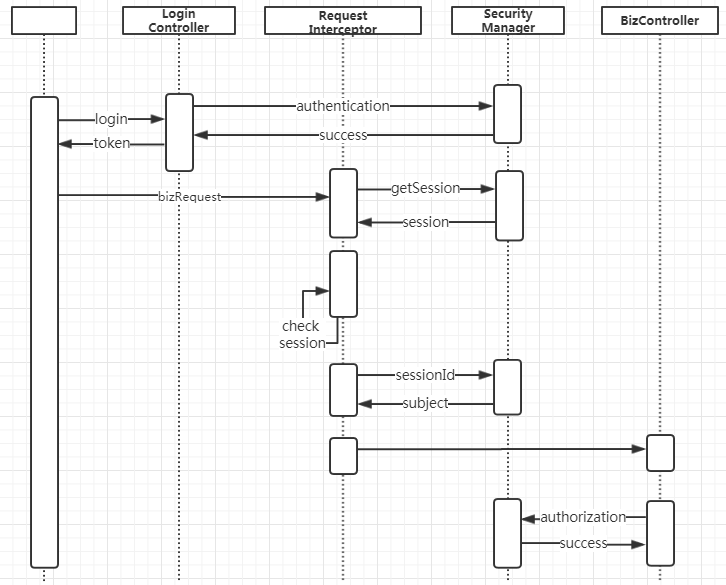
图3 合并时序
- Authentication时序
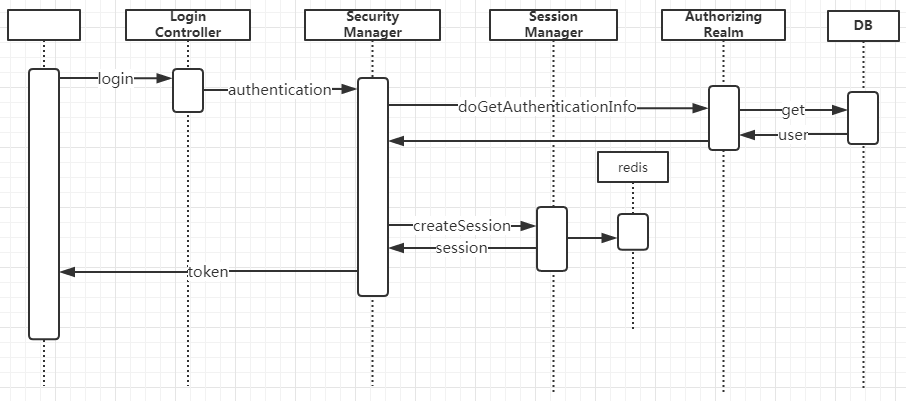
图4 Authentication时序
- Authorization时序
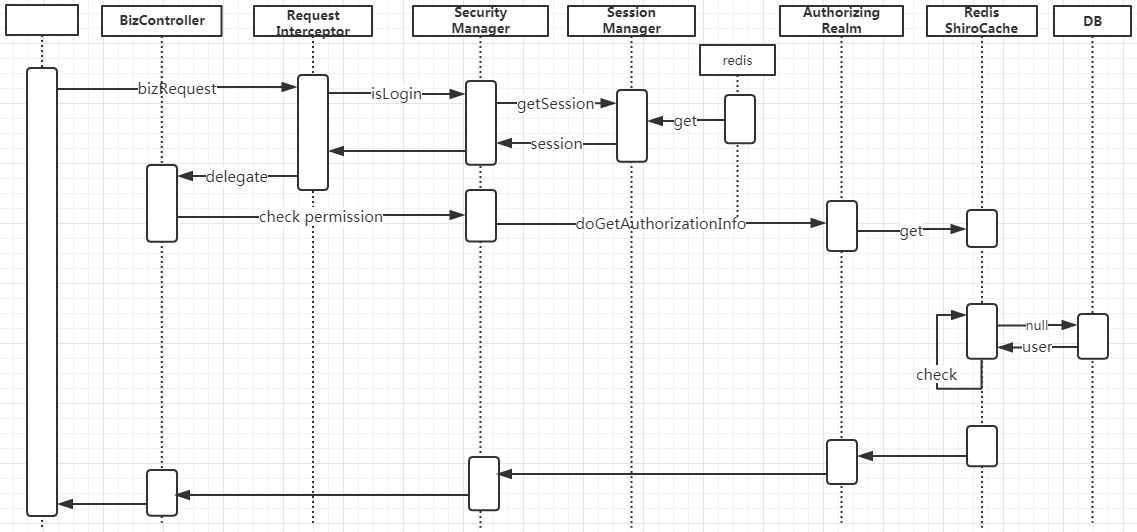
图4 Authorization时序
5,总结
在使用Shiro框架进行Authentication和Authorization实践时,虽然根据不同的业务场景需要做不同的修改或调整,但是基本也是最佳的实践方式是时刻围绕Shiro的设计原则和已有可借鉴的实现方案来操作,尽可能少或者不修改,从而避免一些预想不到的Bug。最后,重提前言部分说到的,除非是一定要通过共享缓存的方式共享session,否则还是使用Shiro默认的session管理。


